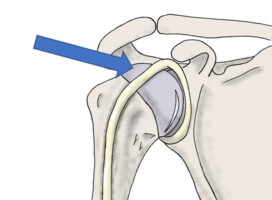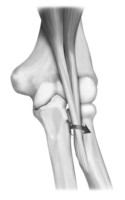An Overview of Bicep Tendon Injuries
Bicep tears can be related to a shoulder injury or an elbow injury. The biceps is the muscle located on the front of the upper arm–just under the shoulder. It is a strong muscle in the upper arm region that helps you to rotate your arm, lift things and twist your elbow. The biceps tendons attach the biceps muscle to bones in both the elbow and the shoulder. If these tendons become torn, either through a fall, a sports related injury (see Injury Overview) or from extreme wear and tear, strength in the upper arm can become lost and movement in the upper arm can be painful.
There are a couple of varieties of a biceps tendon tear:
- A partial tear is a tear that does not completely sever the tendon
- The tear can occur at the shoulder (proximal tear) or at the elbow (distal tear)
The above pictures illustrate the biceps muscle and its attachments both near the shoulder (Figure A) and the elbow (Figure B). The blue arrow points to the long head biceps tendon, which is the tendon that is most commonly affected by injury.
Most tears are the result of on-going, continuous strain and wear and tear on the biceps muscle and tendon. This is most commonly seen in weight and strength training and usually starts with just a simple fraying of the tendon. As the injured tendon progresses, it will eventually tear. These tears can occur in two distinct ways:
- At the shoulder joint: A proximal biceps tendon rupture is an injury to the biceps tendon as it enters the shoulder joint. The tendon is vulnerable to injury here because it makes a sharp right-turn to enter the shoulder joint and it moves in and out the shoulder up to 2 inches with shoulder motion. This is the most common area for the bicep tendon to tear and typically occurs in patients 60 years of age or older. This injury if frequently associated with rotator cuff tears. In some instances it creates minimal symptoms and can heal on its own; in other cases there is significant deformity (Popeye muscle) and cramping. In some cases surgery can be helpful to treat the symptoms of cramping, weakness, and deformity.
- Biceps Tendon Tear or Rupture at the Elbow Joint: A distal biceps tendon rupture is an injury that occurs at the elbow joint. It most commonly affects middle-aged men and is caused by heavy lifting or sports. There is usually a loud 'pop' when the tear occurs. Most people who suffer from this injury will need to have surgery in order to reattach the tendon at the elbow.
What are the symptoms of biceps tendon injury?
Symptoms associated with a torn biceps tendon include sudden, sharp upper arm pain—sometimes with a noticeable snap or popping sound. Cramping, bruising, pain and tenderness of the shoulder, biceps and elbow are common. In addition, it will most likely be difficult to turn the palm up or down.
How is a biceps tendon injury treated?
It is important to note that the biceps has two attachments at the shoulder: a long head and a short head. The long head is the tendon at the shoulder that is most frequently injured. Short head biceps injuries are exceedingly rare, while long head biceps injures are exceedingly common. Because of this second attachment at the shoulder, many people can still function and use their biceps even when the long head of the biceps is severely damaged or completely torn. With that said, many people can still function with a biceps tendon tear, and only need simple treatments to relieve symptoms.
Non-Surgical
Treating a torn biceps tendon non-surgically will include resting the arm that is injured and avoiding any heavy lifting or the activity that may have caused the injury (i.e. weight training). Applying cold packs and ice will help with swelling and overall pain. You can also take anti-inflammatory medications and non-steroid drugs for pain relief. Dr. Millett will consult with you on various at-home physical therapy exercises that can be done to help with flexibility and strength.
Surgical
Several new torn biceps tendon procedures are available to repair the injured tendon with minimal incisions using arthroscopic surgery. The goal of the surgery is to re-anchor the torn tendon back to the bone. At the shoulder, the long head of the biceps is typically re-attached using a subpectoral (deep to the chest muscle) approach that anchors the long head biceps tendon into the upper part of the arm bone (proximal humerus) using a small screw and suture. Dr. Millett has literally done over a thousand of these procedures with excellent success. Once it is healed patients have normal strength and function, the scar becomes invisible in the armpit, and the muscle appearance returns to normal. When the biceps tendon is injured at the elbow, the repair is done with a small incision and the torn tendon is reattached to the forearm bone (radius) using sutures and a small fixation device. Dr. Millett has also been involved with the development and teaching this technique. Excellent results can be expected with full recovery in 3-4 months.
For additional resources on bicep tendon injuries, please contact the office of Dr. Peter Millett, serving patients in Vail, Aspen and the surrounding Denver, Colorado communities.


